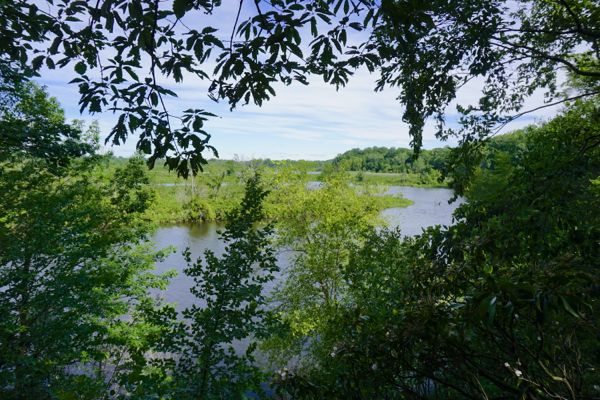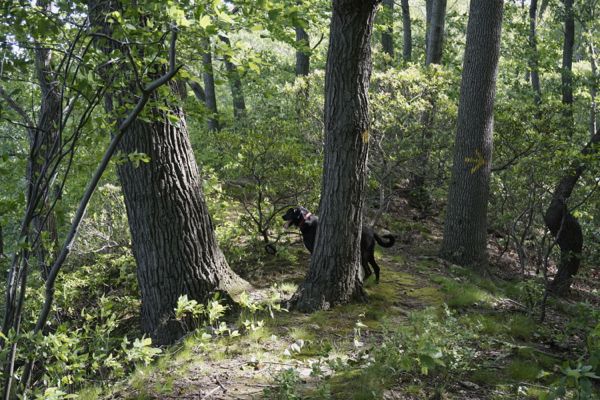A moss covered crotch of two lovely Linden trees provides a perfect perch over Crosswicks Creek and the Hamilton – Trenton marsh.
As we approach the spot today, a red tail hawk screeches loudly, warning us to stay away.
If you’re lucky, you can see red tails and even bald eagle soaring over the marsh – but not today.
There are many such spots of solitude along the Bordentown Bluffs trail, but the Linden crotch is our favorite place to sit and watch the creek flow by.
The canopy of trees lining the bluffs at this spot opens in two places, providing framed spectacular views of marsh and creek – almost as if someone had cleared them just to be able to sit there and get the perfect view. If the openings were a few feet left or right, the ugly PSEG Duck Island power plant or the smokestacks from Pennsylvania factories would come into view. A few feet up or down, and the creek would not be visible.
Today, we are lost in what could be one of those gaudy romantic landscape paintings, with the green of the marsh a perfect contrast with the deep blue sky punctuated by huge brilliant white billowing clouds (no camera today!).
But Thoreau’s “A Week on the Concord and Merrimack Rivers” speaks to us, dispelling such arrogant foolishness: (emphases mine – page 260, Library of America edition)
The trees made an admirable fence to the landscape, skirting the horizon on every side. The single trees and the groves left standing on the interval appeared naturally disposed, though the farmer had consulted only his convenience, for he too falls into the scheme of Nature. Art can never match the luxury and superfluity of Nature. In the former all is seen; it cannot afford concealed wealth, and is niggardly in comparison; but Nature, even when she is scant and thin outwardly, satisfies us still by the assurance of a certain generosity at the roots. In swamps, where there is only here and there an ever-green tree amid the quaking moss and cranberry beds, the bareness does not suggest poverty. The single-spruce, which I had hardly noticed in gardens, attracts me in such places, and now first I understand why men try to make them grow about their houses. But though there may be very perfect specimens in front-yard plots, their beauty is for the most part ineffectual there, for there is no such assurance of kindred wealth beneath and around them, to make them show to advantage. As we have said, Nature is a greater and more perfect art, the art of God; though, referred to herself, she is genius; and there is a similarity between her operations and man’s art even in the details and trifles. When the overhanging pine drops into the water, by the sun and water, and the wind rubbing it against the shore, its boughs are worn into fantastic shapes, and white and smooth, as if turned in a lathe. Man’s art has wisely imitated those forms into which all matter is most inclined to run, as foliage and fruit. A hammock swung in a grove assumes the exact form of a canoe, broader or narrower, and higher or lower at the ends, as more or fewer persons are in it, and it rolls in the air with the motion of the body, like a canoe in the water. Our art leaves its shavings and its dust about; her art exhibits itself even in the shavings and the dust which we make. She has perfected herself by an eternity of practice. The world is well kept; no rubbish accumulates; the morning air is clear even at this day, and no dust has settled on the grass. Behold how the evening now steals over the fields, the shadows of the trees creeping farther and farther into the meadow, and erelong the stars will come to bathe in these retired waters. Her undertakings are secure and never fail. If I were awakened from a deep sleep, I should know which side of the meridian the sun might be by the aspect of nature, and by the chirp of the crickets, and yet no painter can paint this difference. The landscape contains a thousand dials which indicate the natural divisions of time, the shadows of a thousand styles point to the hour.


